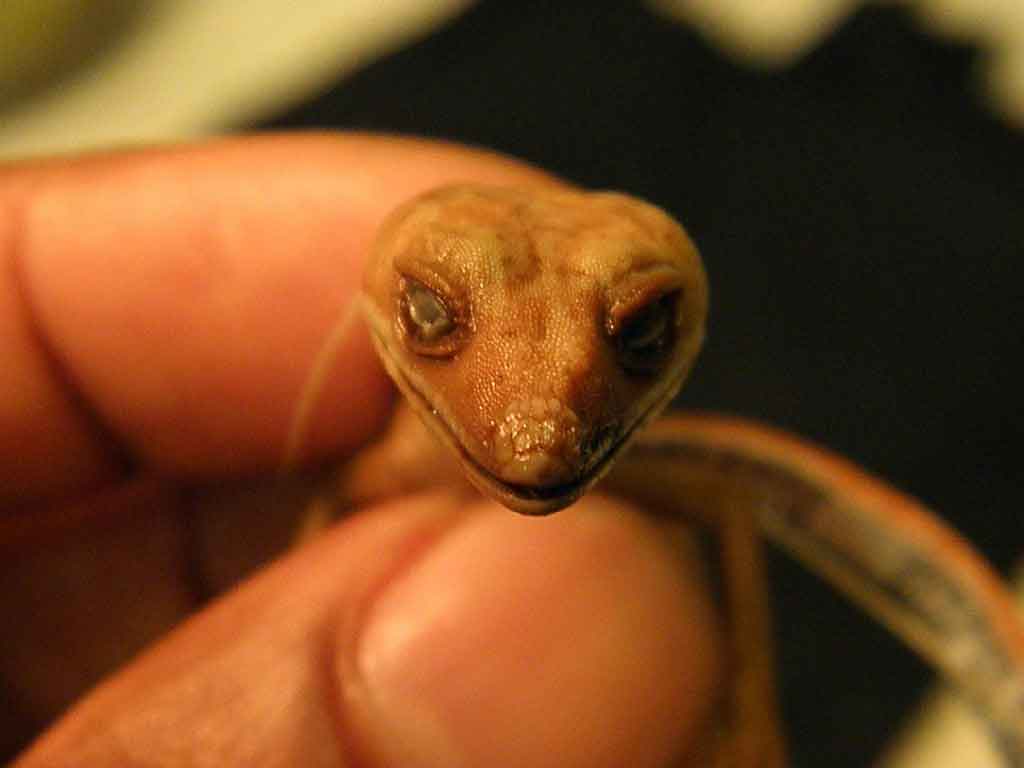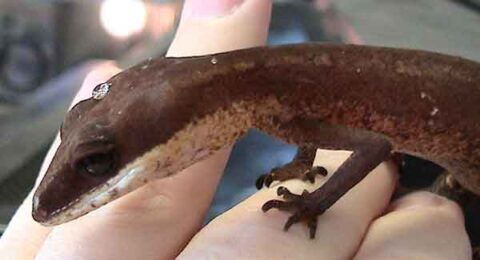
Content |
|---|
Origin
The Cat gecko (Aeluroscalabotes felinus) is a tree species of the family Eublepharidae.
They are found in Indonesia, Malaysia, Singapore and Thailand, where they prefer to live in moist and cool jungles with streams or rivers.
These Geckos occasionally enter the terrarium trade as wild-caught specimens, so most individuals die during transport. Thailand has a law that prohibits the capture, trade, the import and export of gekcos.
Its name comes from its habit of sleeping curled up with its tail over the nose and eyes..
The nominal shape A. felinus felinus was described by Günther in 1864, the subspecies A. felinus multituberculatus was first described by Kopstein in 1927.
Characteristics

The Cat gecko can be measured 12 cm., 21 cm if we add the tail. Males are still smaller.
The head is clearly separated from the body, has an elongated muzzle and is wider than the body.
The neck and body they are flattened laterally and are covered with small dorsal scales, flat and almost uniform. A row of small flat tubers are present, although they may be missing; the ventrals are small, smooth and elongated.
Sexually mature males have an angular row of 25-28 enlarged preanal scales, with 10-23 Pores. Thin limbs end in short, clawed fingers.
The hemipenes clearly visible facilitate sex determination.
The original tail is able to grip, the regenerated one is shorter and bulkier.
Dorsal coloration between dark and reddish-brown, 1 or 2 rows of reddish beige spots, yellow or whitish running from the nape of the neck to the back, often framed in dark color.
The head and limbs are unicolored or with brown patterns; the sides of the body may have irregular and partially indistinct light or dark lines or spots.
Lip and chin protections are whitish, eyes are blackish brown.
The throat is reddish beige, the ventral part is reddish-brown and with small irregular dark spots.
Original tail conspicuous and irregularly stained white. Regenerated tails have only indistinct black and brown spots.
The youth are stronger in their overall coloration.
Habitat
The Cat gecko is an inhabitant of the primary forest from sea level to some 800 m above sea level. There it lies close to the ground, especially moving in the branches of the bushes and possibly also in the trees.
It is a Gecko strictly nocturnal, well hidden during the day. Its mode of locomotion is of a chameleon slowness. Climb skillfully on small branches, using its prehensile tail as an aid to climbing.
The "Cat gecko" in captivity
Terrarium
For a mate or a male with a maximum of 3 females, are enough terrariums of 60 x 40 x 40 cm. (width x depth x height). But, a higher height adapts to the need of this species of Geckos.
The substrate consists of garden soil or a mixture of soil and peat, of about 5 height cm. Make sure the soil is always moist. It is essential that there are branches that animals can climb on., as well as plants, as they like to climb them. Pieces of cork or tubes placed on the ground and in branches serve as a hiding place during the day. Despite constant spraying (at least every two days), you should not miss a bowl of water, since animals visit it frequently and also like to defecate on it. Once a week, spray water should be enriched with a mixture of vitamins.
Terrarium lighting
Lighting is provided by fluorescent tubes, temperatures should be a maximum of 27° C during the day (25°C is better) with a reduction to about 23° C at night.
It is advisable to reduce the lighting time and slightly lower the temperatures in winter.
Food
The Cat gecko eat the usual gecko food in the right size, that is to say, crickets, Little grasshoppers, etc. But, tend to prefer smaller foods. Sprinkle regularly 3-4 times a month with a mixture of lime with vitamins.
Reproduction
Females put 2 elongated soft-shelled eggs several times a year in the moist substrate or in the pot.
At 24-26°C during the day, with an overnight setback at 20-22° C, incubation lasts between 70 and 85 days. The babies measure 43-57 mm y have a length of 75-92 mm.
They must be raised individually.
during breeding, regular vitamin supplementation in the form of lime preparations and in spray water must be guaranteed.
For sale "Cat gecko"
The price of a "Cat gecko" at the exotic animal market, captive bred, ranges between 100 – 300 EUR, depending on its size.
Videos "Cat gecko"
|
|
|
|---|
Alternative names:
1. Cat gecko (English).
2. Gecko chat (French).
3. Katzengecko (German).
4. Llagartixa de gato (Portuguese).
5. "Gecko gato arborícola" (español).
Sources:
GROSSMANN, W. & C. SHEPHERD (2005): Breeding and propagation experiences of the Cat gecko (Aeluroscalabotes felinus) (GÜNTHER, 1864). — SAURIA, berlin, 27 (1): 33-46.
GROSSMANN, W. (in the press): Cat gecko (Aeluroscalabotes felinus). — Münster, species by species, Terrarium Library (Natur und Tier – Verlag GmbH), 64 p.
MANTHEY, U. & W. GROSSMANN (1997): Amphibians & Reptiles of Southeast Asia. – Münster (Natur und Tier – Verlag), 512 p.
